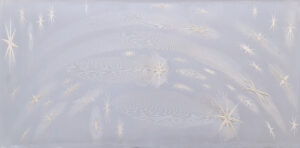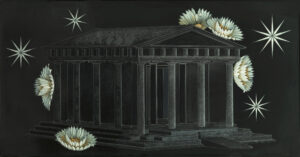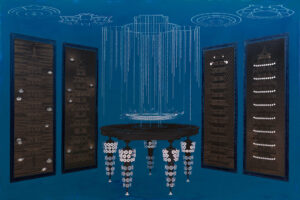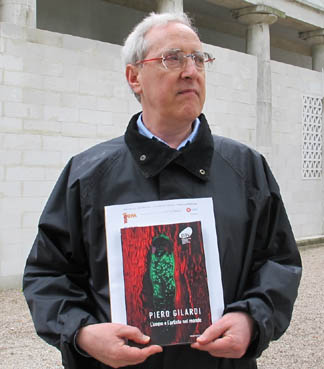Claudio Massini was born in Naples in 1955. In Naples he obtained a painter’s diploma at the Royal Academy of Fine Arts. A soul averse to the theories and practices of those who cherish the “shock of the new”, an inquiring spirit, even if unwilling to deviate more than the lawful from one’s own path of knowledge, he has crossed with the weight of his work years of fashions, trends and currents, always looking for the right way to establish the relationship between the imposing force of the image and the compelling coherence of thought.

Claudio Massini, I sette centri, 2001/2007, 25 x 50 cm
Regarding his debut on the stage of the artistic system, we recall: “Ambiente come sociale”, Venice Biennale, 1976; ” Duello”, Lucio Amelio, Naples, 1989; “Paysages”, Revoltella Museum, Trieste, 1994; “L’altra metà del cielo”, Rupertinuum, Salzburg, 2000; Modern Art Gallery, Bologna, 2003; Mücsarnok Kunsthalle, Budapest, and so on. Working on recomposition, working on form that becomes substance, on thought that becomes form, on aesthetics that intertwine with the artistic is the huge task that Claudio Massini has taken on. His most recent works are centered on the level of strong and easily recognizable signs without being symbolists, and they embody the terms of the divergence without looking at the decadence of the model. Any model, since history is the teacher. History is therefore the point of reference and not chance, nor chaos, although history is also given a meaning, i.e. the wings that can carry it into our daily lives.

Claudio Massini, Prima della storia, 2008, 23 x 50 cm
Here, then, is that his encaustic works are marked by some unmistakable elements that determine their language: the distribution of the module that brings together (or accompanies) the iconographic model; the volume that exceeds the flat surface; the furrow that draws and defines the painting; the line struggling with the plastic configuration; the preciousness of the material that is never flaunted yet is always present; the blotchy effects that refer to the idea of galactic worlds from which the image is released.

Claudio Massini, I fiori della logica, 2009, 17 x 32,5 cm
Claudio, you began your training in Trieste, but then completed your studies in Naples. What did this change of horizon mean to you?
Trieste prevents you from being in a different way than what exists wants you to be and therefore, in a certain sense, the city puts you in order and organizes you to the certainty of the small step. On the contrary, Naples, in the seventies, lived on other registers; therefore I found myself thrown back into a world which, to put it in one word, seemed chaotic to me. These two cities are exactly at the antipodes, but I never found the freedom that Naples offered me anywhere else. Naples, in those years, thanks to the presence of mythical figures such as Lucio Amelio, Lia Rumma and Giuseppe Morra, was a city where international artistic events took place. There I found a gigantic humanity and a greatness of which I saw neither beginning nor end. That incredible forge confronted me with profound questions. There I had to deal day after day with the work of Beuys, Merz, Acconci, Nitsch, Warhol, Gilbert & George, and everything at the highest levels of perfection and any event appeared normal, daily, absolutely logical and necessary.

Claudio Massini, Caos gentile, 2009, 100 x 200 cm
Although you started your journey with aesthetic interventions on the territory and with subsequent developments, your current work is mainly pictorial. What do you want to achieve or affirm with these works?
I work with the image and, for me, using the tools of painting or those of photography is completely indifferent. What matters to me is that the internal sense of the image remains strong. I calibrate this force by paying close attention to all those components that are often overshadowed by many contemporary authors: strong substance, balanced composure, tenacious curiosity, vital force, excellent executive quality.

Claudio Massini, Matrimonio levantino, 2021/2022, 160 x 240 cm
Can you tell us something about your pictorial themes?
With the still lifes, the fragrant plots of coffee, the flowers and the crowns, the interiors and the vials, the firmaments, the sailing ships and the ferries and the boats, the amphorae and the wineskins, the interiors and the panoramas, I wish to reaffirm the metahistorical component of the subject. Since my themes belong to the most consumed images in the art history, on a superficial reading they may seem familiar, but in reality they have a courageous new role which is vitality.

Claudio Massini, XXI secolo, 2009/2010, 200 x 400 cm
What can you tell us about this demanding exhibition at Forma Gallery in Paris?
The first and most important thing to say is that this is an exhibition by Chloé Perrin: it is she who in three years has selected my works from 2007 to today, embodying her sense of elegance with an international and severe gaze. Chloé chose the Forma Gallery for the shrewd and sober nature of the installations. And then Paris, scenography and accumulation of many masters of art, fashion, literature and that joie de vivre that makes every proposal an event… mine lives in 21 paintings.
Roberto Vidali
Info:
Claudio Massini, Le Charme de la Raison
curated by Chloé Perrin
07/09/ 2023 – 23/09/2023
Galerie Forma
127 rue de Turenne, Paris
clo@cloperrin.com
info@forma.paris
www.forma.paris

He is editorial director of Juliet art magazine.






NO COMMENT